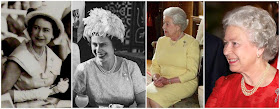 |
| Beatrix and Juliana on the balcony following the abdication ceremony |
The abdication
The abdication occurred on the morning of April 30, 1980 - Queen Juliana's 71st birthday. With a round of signatures, the throne transferred and Beatrix became Queen of the Netherlands. She was 42 years old and had three sons with her husband Prince Claus. Juliana became known once again as Princess Juliana, and died in 2004.The investiture
With no need to wait for the end of a mourning period and plenty of time to plan (Juliana announced her plans to abdicate on January 31st), the investiture of the new queen took place on the same day. The Dutch do not have a coronation, exactly, but they do get out the ermine robe for the new monarch. The Crown regalia is displayed during the ceremony, but the crown is not worn.Beatrix wore the Pearl Button Tiara while she swore her oath to her people and the constitution of the Netherlands in front of dignitaries and representatives from foreign royal families in the Nieuwe Kerk. Unfortunately, Beatrix's big day was scarred by violence outside, as protests about poor housing conditions and the monarchy turned ugly.
After taking the reins, Beatrix announced that the official celebration of her birthday - Koninginnedag, or Queen's Day - would remain on April 30th in honor of her mother (Beatrix's own January birthday was not conducive to outside celebration anyway). The extended royal family joins in celebrations around the country, visiting different locations each year. Street fairs and festivals and merriment ensue.
This year marks Beatrix's 32nd on the throne, and people continue as they have for several years to speculate that an abdication might be imminent. Known as the Prince of Orange, Beatrix's oldest son Willem-Alexander is next in line for the throne. He's set to become the first King of the Netherlands since Willem III died in 1890. But since he and wife Princess Máxima have only daughters, the line will swing back to a queen regnant when Catharina-Amalia, the Hereditary Princess of Orange, takes the throne.
Photos: National Archives
















































